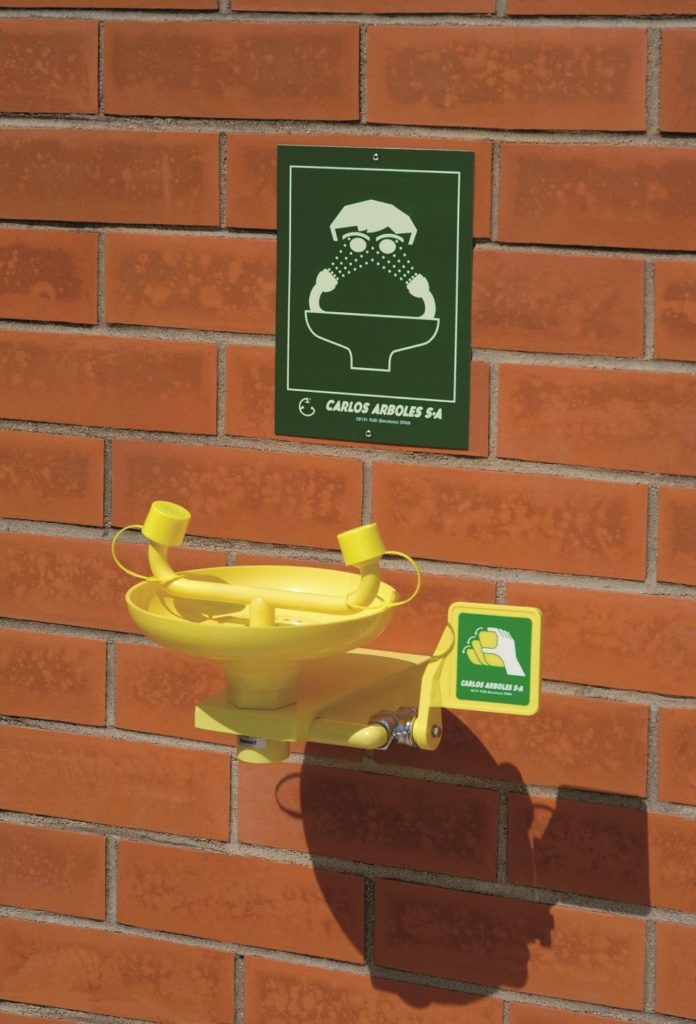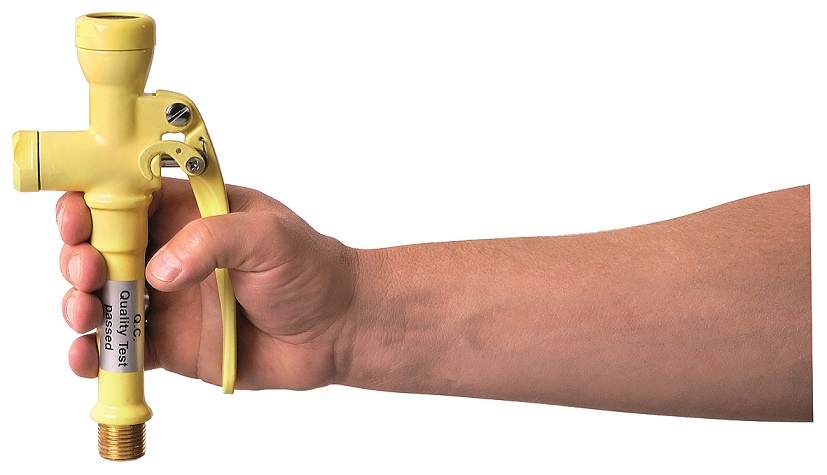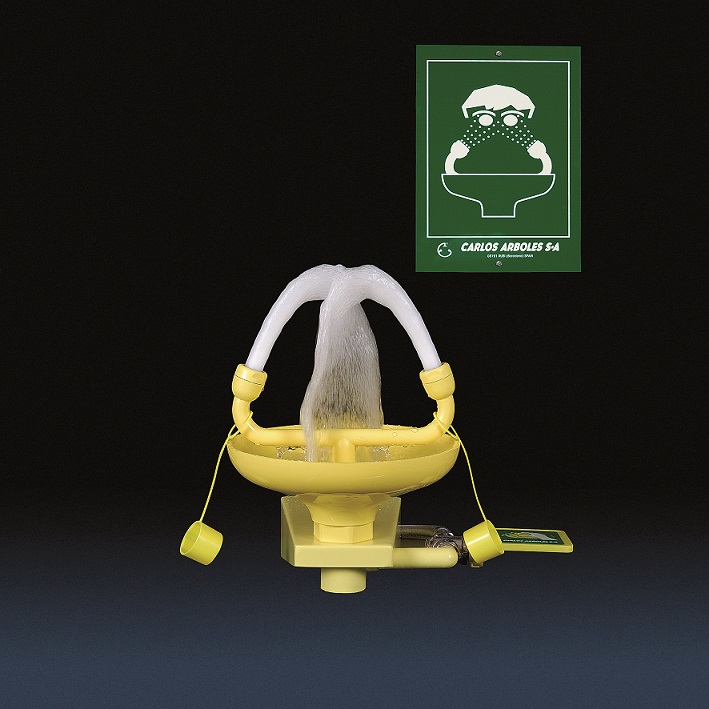Your basket is currently empty!
The Ultimate Guide to Emergency Eyewashes
Ensuring Workplace Safety with ANSI Standards
Hey there! Imagine you’re in a busy laboratory or workshop, handling chemicals when suddenly something splashes into your eyes. Not ideal, right? That’s where emergency eyewashes come to the rescue. These lifesaving devices, also known as safety eyewashes or emergency eye wash stations, are essential for quickly and effectively flushing out harmful substances and preventing serious injury. In this guide, we’ll dive into everything you need to know about emergency eyewashes, including key ANSI standards and reliable options from us at Arboles. Whether you’re a safety manager, business owner, or just curious, let’s keep those eyes safe!

A wall mounted emergency eyewash operated by a push handle.
What Are Emergency Eyewashes and Why Do They Matter?
Emergency eyewashes are specialised fixtures designed to deliver a steady and constant stream of water or flushing fluid to rinse the eyes and face in case of exposure to hazardous materials. They’re a must-have in environments like laboratories, factories, construction sites and anywhere chemicals, dust, or debris pose a risk. Think of them as your first line of defence against eye injuries. According to occupational safety experts, prompt flushing can reduce the severity of chemical burns or irritations dramatically. Without a proper emergency eyewash nearby, a minor accident could turn into a major problem, leading to vision loss or long-term damage. That’s why regulations emphasise having these safety eyewashes readily available.
The Role of ANSI Standards in Emergency Eyewash Safety
When it comes to standards, the ANSI/ISEA Z358.1-2014 is the gold standard for emergency eyewash and shower equipment. This guideline sets uniform minimum requirements for performance, installation, and maintenance to ensure these devices work effectively when needed most.
Here’s a quick breakdown of some key ANSI requirements:
- Location and Accessibility: Emergency eyewashes must be within 10 seconds (or about 55 feet) of potential hazard areas, on the same level, and free from obstructions. They should be well-lit and clearly marked for easy identification.
- Water Flow and Pattern: The eyewash must provide a minimum of 22L/min, delivering tepid water (60-100°F) for at least 15 minutes. The stream should be soft and aerated to avoid further injury.
- Testing and Maintenance: Units need weekly activation to ensure they’re free of debris and functioning properly, plus an annual inspection for full compliance.
Adhering to these ANSI standards isn’t just about compliance—it’s about protecting people. OSHA often references ANSI Z358.1 in citations, making it crucial for avoiding fines and ensuring a safe workplace.

An emergency hand held eyewash which id operated by squeezing the trigger.
Types of Emergency Eyewashes: Finding the Right Fit
Emergency eyewashes come in various forms to suit different needs. Here’s a look at the main types:
- Plumbed Bench Mounted Eyewashes: Connected to a water supply, these provide unlimited flushing time. They’re perfect for high-risk areas and often combined with safety showers for full-body protection. Have a look at the 3120 or 2212 as examples.
- Plumbed Wall Mounted Eyewashes: Again, connected to a water supply and installed on the bench. Some options are the 2210 or the 3000 which are popular in school laboratories etc.
- Combination Units: These integrate an eyewash with an emergency shower, offering comprehensive decontamination. Products such as the 4220, 4250 & 4285 will tick this box.
For instance, we offer ANSI-certified floor-mounted emergency eye washes that are easy to install and use, making them a popular choice for labs and industrial spaces. Our combination units ensure both eye and body safety in one convenient station.
Installation and Maintenance: Keeping Your Safety Eyewashes Ready
Proper installation is key to meeting ANSI standards. Start by assessing hazards in your workspace to determine placement—remember, that 10-second rule! Professional installation ensures correct water pressure and temperature.
Maintenance is equally important:
- Weekly Checks: Flush the unit for a few seconds to clear lines and verify flow. We supply check cards with our products.
- Annual Inspections: Test for the full 15-minute duration, check temperature, and inspect components.
- Spare Parts: Keep essentials on hand, like replacement heads or brackets. We provide a range of spare parts for our emergency eye washes, such as bull horn head assemblies, to keep everything in top shape.
Regular training for employees on how to use these devices can make all the difference in an emergency.

The Arboles 2212 – Emergency eyewash in full flow!
Choosing the Best Emergency Eyewash for Your Facility
When selecting an emergency eyewash, consider factors like hazard type, space, and budget. Look for ANSI compliance to guarantee reliability. We are an excellent resource—as we’re manufacturers of emergency devices and emergency safety products, including certified emergency eye washes and showers that meet ANSI, EN, and DVGW standards. Their range includes wall brackets and other accessories for seamless integration.
Pro tip: Consult with safety experts or suppliers to customise your setup. Investing in quality safety eyewashes not only boosts compliance but also shows your team that their well-being matters.
Wrapping It Up: Prioritise Eye Safety Today
Emergency eyewashes are more than just equipment—they’re vital for protecting vision and promoting a culture of safety. By following ANSI/ISEA Z358.1 standards and choosing trusted providers like us, you can ensure your workplace is prepared for the unexpected. If you’re setting up or upgrading your safety eyewashes, check out our range of emergency eyewashes for top-notch options.
Have questions about emergency eyewashes? Contact us!
